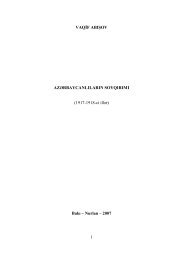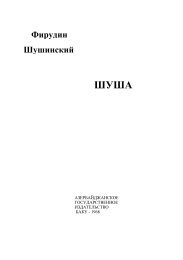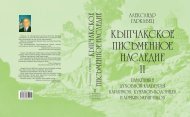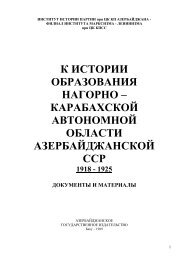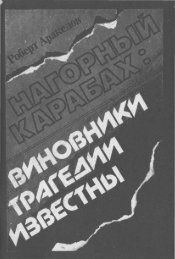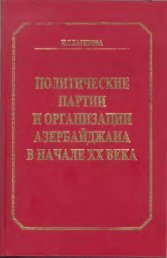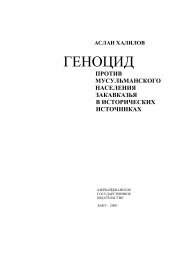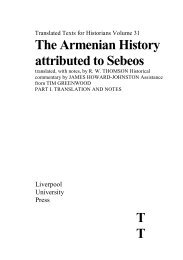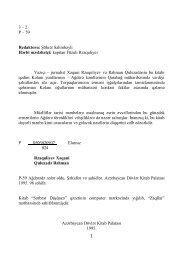ARMENIAN - Erevangala500
ARMENIAN - Erevangala500
ARMENIAN - Erevangala500
Create successful ePaper yourself
Turn your PDF publications into a flip-book with our unique Google optimized e-Paper software.
The Turmoil o f a War<br />
That Would Not End<br />
Turks and Armenians between the Treaty o f Brest-Litovsk<br />
(December, 1918) and the Treaties o f Gtimru, Moscow,<br />
and Kars (October, 1921)<br />
Between 1917 and 1918, the collapse o f the Russian<br />
Czar-dom robbed the Western powers o f their great<br />
Eastern ally, thus giving the Central Powers a little<br />
breathing-space. Armenian irregulars continued fighting<br />
on the eastern Anatolian and Egyptian-Arabian fronts<br />
and attacking the Turks, Austrians, and Germans with<br />
rhetoric. During this period, the Armenians became a<br />
factor to be reckoned with in the battle against the<br />
Ottoman Empire, Austria-Hungary, Bulgaria, and<br />
Germany, who were all putting up a tough defense.<br />
Now, negotiations were finally held that had a certain<br />
real foundation. The concessions made to Czarist Russia<br />
in the Sykes-Picot Agreement had served the Czar's<br />
interests, not those o f the ever-hopeful Armenian<br />
extremists (extremist not only in their political methods,<br />
but also in their exaggerated expectations).<br />
Communist-Bolshevist Russia would long remain an unknown<br />
entity. (No one could have guessed that its politics<br />
would differ in absolutely no way from those o f the<br />
Czars; the Armenians suspected this least o f all!) So after<br />
the collapse o f the Czardom, everything that had been<br />
promised to the Czars in the Sykes-Picot Agreement was<br />
now promised to the Armenians. It was thus reasonable to<br />
expect them to distinguish themselves a little bit more in<br />
the fight against the Ottoman Empire! Lloyd George, in<br />
his well-known flowery style, described Armenia as a<br />
land "soaked with the blood o f innocents". Little did he<br />
know that he was telling the truth but that the blood was<br />
mostly that o f Moslems, who in fact had many more dead<br />
to mourn than the "Christian" Armenians. Lloyd George<br />
was just as much a hypocrite as Wilson and Clemenceau.<br />
They had all picked out a "romantic" victim and then<br />
dropped her by the wayside as soon as she ceased to be<br />
useful.<br />
When the "peace conference" - which was actually nothing<br />
but a dictate-preparation conference - began meeting<br />
in Paris in January of" 1919, it appeared as if the Armenian<br />
extremists' hour had arrived. The Armenians sent two delegations<br />
to the "peace conference". One was led by the<br />
professional emigrant Boghos Nubar, who had been<br />
working towards the dismemberment o f the Ottoman<br />
Empire for many years. The other was from the Republic<br />
o f Armenia (the existence o f which had only been made<br />
possible by the Turks after the Treaty o f Baku on May 28,<br />
1918).<br />
The two delegations immediately began "auctioning" -<br />
outbidding each other in demands for territory and underbidding<br />
each other in rational arguments. They were<br />
apparently confusing politics with a carpet bazaar, where<br />
the important criteria are the pattern, the number o f<br />
square meters, and the age o f the desired item. Their<br />
demands became so excessive that even such inveterate<br />
carpet-lovers as the Allied rulers lost interest in making a<br />
real offer. After all, it did not have to be an Armenian carpet.<br />
Those o f the Turks were much older, more valuable,<br />
and more reliable.<br />
After the Armenian delegation led by Boghos Nubar<br />
started things o ff by demanding an Armenia in eastern<br />
Anatolia, the joint delegation (the group led by Avetis<br />
Aharonian from the Republic o f Armenia had in the<br />
meantime merged with Nubar) worked its way up to territorial<br />
claims stretching from the Black Sea, with Trabzon<br />
as a harbor, all the way to Cilicia.<br />
The Armenian population o f this "Greater Armenia"<br />
would not even have accounted for a fifth o f the total population<br />
o f the region - and that is based on the figures<br />
from 1914! Moreover, even if back then in 1914 the<br />
entire Armenian population o f the world had gathered in eastern<br />
Anatolia, there still would not have been an Armenian<br />
majority in the region.<br />
But so what? In the nineteenth century, the various<br />
Armenian churches had wrestled over who was the "most<br />
Armenian". Later, the Dashnaks and Hunchaks both<br />
wanted to carry o ff the palm in the fight to be the best terrorists.<br />
And now, the delegation from the Republic o f<br />
Only the foundation walls remain o f this village church above<br />
Lake Van in Bakracli Koyii, on the way to Yedikilisse-W arak-<br />
wank.<br />
The authorities are well aware o f the lamentable condition o f<br />
many historical Armenian buildings. There is, however, a far<br />
greater number o f Seljuk and Ottoman buildings in even worse<br />
condition. (In many cases as a result o f the devastation o f the<br />
civil war o f 1915.) These are naturally given priority in any<br />
preservation or restoration project.<br />
107



